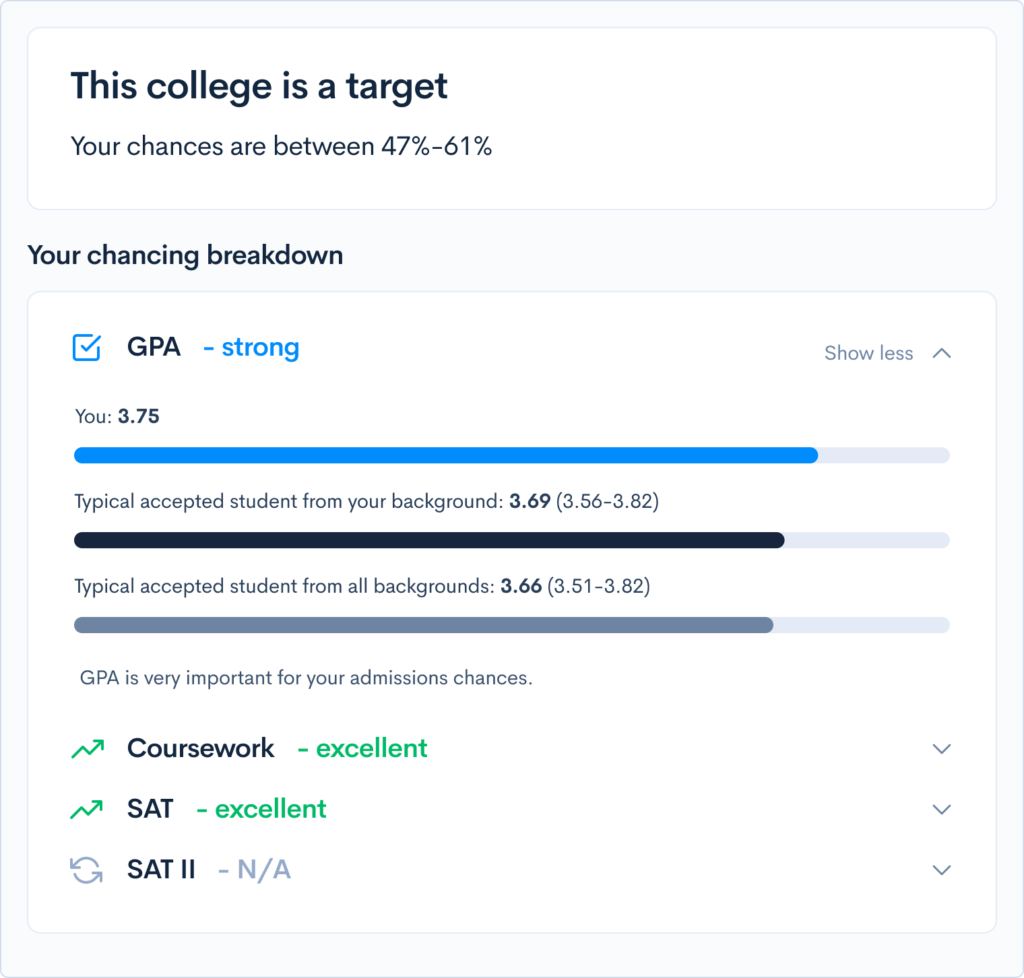15 Commonly-Missed SAT Grammar Rules
When taking the SAT Writing & Language section, students often miss questions because certain answers may sound right when they actually contain a grammatical error. To avoid such mistakes, you need to read carefully and have a firm grasp of English grammar. In this post, we will cover 15 commonly-missed grammar rules and how to avoid them. The SAT Writing & Language Section is one of two parts of the Evidence Based Reading and Writing portion of the SAT. The Evidenced Based Reading and Writing portion is scored out of 800 and combines with the Math portion of the SAT for a total score of 1600. The Writing & Language Section requires students to do three main things: read, find mistakes and weaknesses, and fix them. There are 44 questions in total, and students are given 35 minutes to complete them. Each question is embedded within a passage, and there are four passages (with eleven questions each) on this section of the test. Questions can test command of evidence, words in context, analysis in history/social studies/science, expression of ideas, and standard English conventions. This last category constitutes the largest portion of the test: therefore, it is important to remember these fifteen grammar rules to better your chances of scoring well on the SAT Writing & Language section. The SAT plays a significant role in your chances. In fact, at selective universities, admissions committees may use applicants’ grades and test scores to filter out academically-unqualified candidates. To figure out if your SAT score stacks up, use CollegeVine’s free Admissions Chances Calculator. This tool will allow you to see how your SAT score compares to other applicants, predict your odds of admission, and even give you additional tips on how to improve your profile! Questions involving this rule can be difficult because incorrect answer choices can be grammatically correct, but are ultimately not as good of a choice as the correct one. To avoid making a mistake with parallel structure, pay close attention to verb tense. Correct answer choices almost always involve sentences with consistent structure throughout. For example, take a look at this question. Correct Answer: C To answer this question, it is important to look earlier in the sentence: the other verbs, “evaluating,” “assessing,” and “improving” all end in -ing. Therefore, the best answer choice is “designing” since it will continue the parallel structure of the sentence. A common writing mistake is the misuse of semicolons. Semicolons should only be used to join two independent clauses. Independent clauses are phrases that can stand alone as a sentence. To check whether a semicolon can be used, make sure the phrases before and after the semicolon can each stand alone as a grammatically correct sentence. Here is an example question involving semicolons. Correct Answer: B In this case, the phrase preceding the semicolon, “Because digital systems record indiscriminately,” is a dependent clause since it cannot stand alone as a sentence. Because we do not have two independent clauses, we cannot use a semicolon nor a period, so choices A and C are incorrect. Also, choice D is incorrect because the “therefore” is redundant since the sentence started with “because.” So, the answer here is B, which correctly joins a dependent and independent clause with a comma. This grammar rule might seem intuitive, but it is very easy to miss. Parenthetical commas are placed around a parenthetical phrase, which is a phrase that is often used for clarification and can be omitted from a sentence without disrupting it. To answer questions involving parenthetical commas correctly, take note of whether you can remove the words in between the commas. This question demonstrates parenthetical comma usage. Correct Answer: C For this question, the phrase “an associate professor of geology at Ohio State” is a parenthetical because it emphasizes the preceding noun, “Jason Box.” Answer choices A and B are wrong since they each surround the parenthetical with only one comma. Also, answer choice D is wrong because it doesn’t include “at Ohio State” in the parenthetical. Therefore, the answer is C because it correctly places a comma on either side of the entire parenthetical phrase. Knowing when to use who and whom is a classic grammatical challenge. This distinction can often cause confusion, as both words can sound correct in a given sentence. “Who” is a subjective pronoun and therefore has an associated verb. “Whom” is an objective pronoun and is the object of the sentence. An easy way to check which one to use is to replace “who/whom” with “he/him” or “she/her.” For example, take a look at this question. Correct Answer: D To figure out whether to use “who” or “whom,” let’s use “she” and “her” instead. The new phrase becomes “she uses them” or “her uses them” (Note: we also replaced “use” with “uses” since she and her are singular pronouns). We can see here that “she” makes more sense in this context, so we should use “who” instead of “whom.” Therefore, answer choices A and B are incorrect. To determine whether the answer is C or D, we should consider whether “who” is singular or plural in this context. Here, “who” refers to the noun “people,” which is plural. So, to have subject-verb agreement, the correct answer choice is D since it has “use” instead of “uses.” Many students are hesitant to pick “NO CHANGE,” but statistically, it should be correct around 25% of the time, and may be the best option. Many SAT Writing & Language questions involve choosing between different types of punctuation. In general, it’s important to remember the following conventions: Let’s explore the differences between these types of punctuation with the following example. Correct Answer: A To answer this question, it’s important to consider the sentence as a whole. In this case, the punctuation after hydrant is being used to separate items in a list. Therefore, the best option is answer choice A. Since the punctuation is in between the second and third items in the list, both answer choices B and C disrupt the flow of the sentence and are incorrect. Also, choice D is incorrect since there needs to be some punctuation to separate the clauses “a pigeon pecking for crumbs around a fire hydrant” and “an old man tending to a baby outside a doorway.” Comma splices are an easy error to overlook. A comma splice is when a comma is incorrectly used to join two independent clauses. Commas can only join two independent clauses when it is followed by a coordinating conjunction (for, and, but, or, yet, so). Here is an example of a comma splice. Correct Answer: C For this question, all answers except for C contain a comma splice. Using “it,” “this,” or “that” makes the phrase after the comma an independent clause. However, since the phrase before the comma, “The plastic hardens quickly,” is also an independent clause, using a comma here results in a comma splice. Instead, starting the phrase with “which” makes it a dependent clause, since “which allows the printer to build the layers of the final model” is not a complete sentence on its own. Therefore, using “which” after the comma is the only correct option. These questions don’t necessarily test a specific grammar rule, but instead test the ability to perceive redundancy. Because incorrect answer choices are often still grammatically correct, these questions can be easy to miss. To best answer these types of questions, consider whether additional adjectives contribute a unique description of the noun. For example, here is a sample SAT question which tests redundant adjectives. Correct Answer: A While adding “well-known” or “commonly known” to the sentence here is not technically grammatically incorrect, these adjectives contribute no additional meaning since they are almost equivalent synonyms to “famous.” So, the correct answer is A, which just uses “famous” to describe the noun “images.” Again, you shouldn’t hesitate to pick “NO CHANGE” if it’s the best option. [amp-cta id="9459"] Passive voice is wordy and often not the best option. A way to distinguish between the active and passive voice is that active voice often follows the order of subject, verb, object. Passive voice, however, often has the format of object, verb, subject. This is an example that tests whether to use passive or active voice in a given context. Correct Answer: B For this question, the phrases “loved by them” and “loved by him or her” are in the passive voice, and the phrases “they love” and “he or she loves” are in the active voice. To figure out the correct answer, first decide if the pronoun should be they/them or he/him and she/her. In this case, the pronoun refers to the noun “people” we should use they/them. Then, we must decide between answer choices A and B. In this case, we should use active voice because passive voice unnecessarily complicates the sentence: it is unclear whether “them” is referring to “the arts” or “people.” Therefore, the correct answer would be B since it has the right pronoun and is in the active voice. The SAT often asks questions involving common idioms. Incorrect answer choices will have a slight variation of the idiomatic expression, such as with an incorrect preposition or the wrong ordering of words. Answering these questions correctly requires knowing the phrases themselves, and reading often or having a strong command of the English language will make them easier. For example, this question involves an idiom. Correct Answer: B This question can be difficult, because though B is not a very common expression, it is the correct answer. To correctly choose B, a good strategy is to eliminate the other answer choices. Choice A is incorrect since “taking on” implies that “investigative journalism” is challenging or going against “the public interest.” Choice C is incorrect because “overtaking” implies that “investigative journalism” dominates or controls “the public interest.” Finally, Choice D is incorrect since “taking off from” implies that “investigative journalism” is using “the public interest” as a starting point, but the rest of the sentence gives no indication as to where “investigative journalism” would go from there. As a result, B is the correct choice since it demonstrates that “investigative journalism” is motivated by “the public interest.” For these questions, you will be asked to pick the best word choice from a list of synonyms. These questions are designed to test your understanding of word meanings in context. Here is a question which involves selecting the correct word. Correct Answer: D Though these words have similar meanings, “promise” makes the most sense within the context of the sentence. Choice B is incorrect because “subscribe” doesn’t fit the right meaning of the word. Choices A and C are similar in that their meanings are almost correct, but they ultimately don’t quite match the formal tone, since the sentence discusses researchers. Therefore, “promise” is the best choice for this sentence. To best answer questions about transitions, look at the preceding sentence to evaluate the context. Here is a sample SAT question which asks for the correct transition. Correct Answer: B The first step to answering this question is eliminating choices C and D. “Therefore” and “consequently” essentially mean the same thing, so they are both likely to be incorrect. Also, these transitions apply cause and effect, but that is incorrect in the context of the previous sentence. The correct answer choice is B since the sentence is emphasizing and elaborating on what was said in the previous sentence, and “in other words” is a good transition for that goal. The trickiest modifier questions on the SAT Writing & Language section involve modifying phrases. With these questions, keep in mind that the phrase modifies the noun immediately after or before it. This question provides some insight into misplaced modifiers. Correct Answer: B In this sentence, the modifying phrase is “Approaching a doorway in which dangles a red envelope filled with green paper money.” Therefore, the noun which comes after this phrase must be what it is modifying. So, choices A, C, and D are incorrect since they modify the lion’s teeth or the envelope. The lion’s teeth and envelope are not approaching the doorway; rather, it is the lion who is approaching the doorway. Choice B is the best answer since the phrase correctly modifies the noun “lion.” The SAT often requires you to combine two sentences. An important thing to note is that such combinations should simplify the passage, not over complicate it. Try to combine the sentences in the most efficient and simple way possible. For instance, this sample question asks you to combine sentences. Correct Answer: A Choice A is the best answer for this question, since it combines the sentences in a way that is grammatically correct and efficient. Choice D is grammatically incorrect since the semicolon is used incorrectly. Choices B and C are technically grammatically correct, but contain unnecessary words which add no additional meaning. Questions regarding comparative clauses are easy to miss since most answer choices sound correct. To avoid being tricked, ask yourself what items are being compared. This example illustrates how to answer such questions correctly. Correct Answer: D In this question, the objects that we are comparing to are “the moves in the dance.” So, the correct answer must be similar to this. Choices A and B essentially mean the same thing and incorrectly compare “the moves” to “martial arts and acrobatics.” Choice C is incorrect since it compares “the moves” to people. Choice D is the best choice since the pronoun “those” refers to the moves in martial arts and acrobatics, and the sentence correctly compares them to “the moves in the dance.” This rule is deceptive in that it seems simple. However, it’s very easy to make mistakes regarding subject-verb agreement. When answering these questions, take care to identify the proper subject so that the correct verb form can be chosen. Here is a question involving subject-verb agreement.
Correct Answer: B First, let’s identify the subject. In this question, the subject is “variations,” not “deformation.” Correctly identifying that the subject is “variations,” eliminates answer choices A, C, and D since they all contain verbs which agree with a singular subject. However, since our subject is plural, B is the only correct answer choice. We hope this post has helped you brush up on these difficult grammar rules! Here are some more resources that may help: What’s Covered:
Overview of the SAT Writing & Language Section
How Will the SAT Impact My College Chances?
15 SAT Grammar Rules You Need to Know
1. Parallel Structure
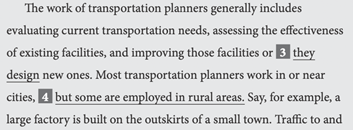

2. Use of Semicolons

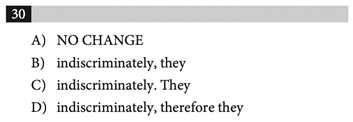
3. Parenthetical Commas
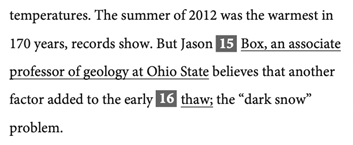
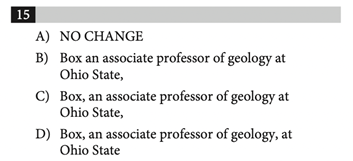
4. Who/Whom


5. Punctuation
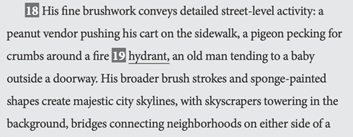

6. Comma Splice

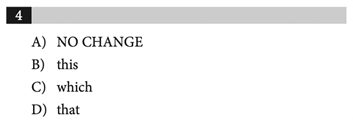
7. Redundant Adjectives

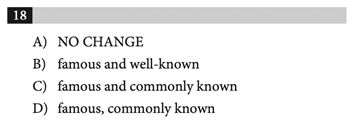

8. Passive vs. Active

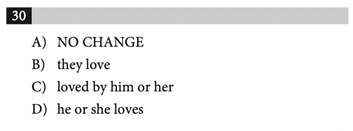
9. Idioms

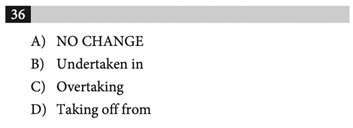
10. Word Choice


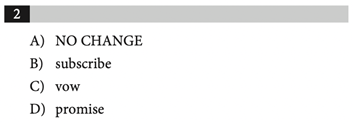
11. Transitions
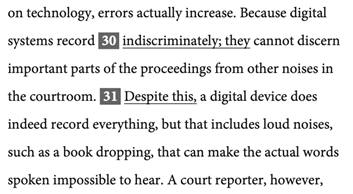
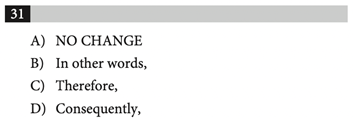
12. Misplaced Modifiers
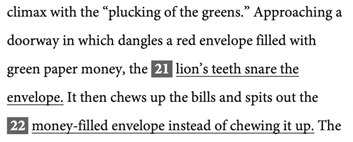
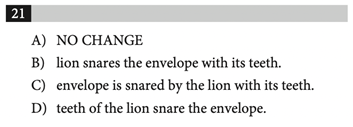
13. Combining Sentences

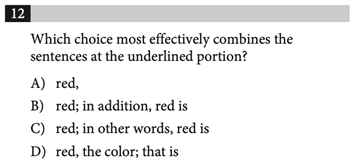
14. Comparative Clauses

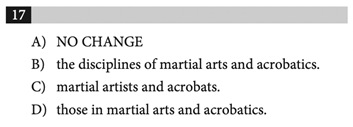
15. Subject-Verb Agreement

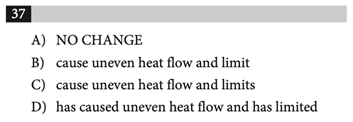
Final Tips
